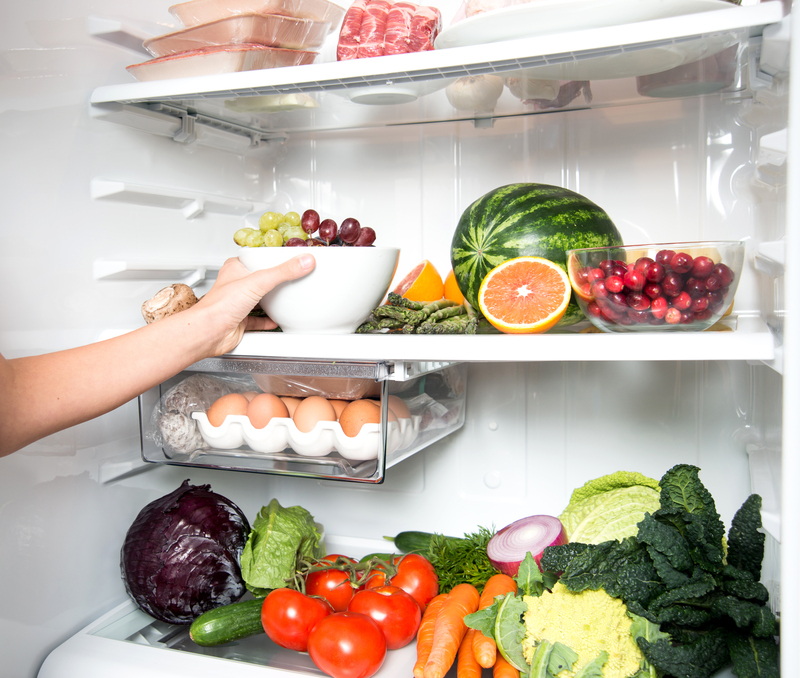Steps for Properly Storing Your Freezer
Posted on 09/06/2025
Steps for Properly Storing Your Freezer
Keeping your freezer organized and properly stored is crucial for food safety, efficiency, and minimizing waste. Freezer storage may seem straightforward, but following optimal techniques ensures that your foods remain fresh, last longer, and are easily accessible when needed. Whether you have a standalone deep freezer or a combination refrigerator-freezer in your kitchen, understanding the best practices can make a noticeable difference. In this comprehensive guide, you'll learn the step-by-step process for properly storing your freezer, best practices for organization, and tips to keep everything running smoothly.

The Importance of Proper Freezer Storage
Improperly stored food can lead to freezer burn, lost food, and even foodborne illnesses. Not only does organizing your freezer help you save money, but it also minimizes the time you spend searching for ingredients and keeps your appliance running efficiently. Let's explore the most effective steps for maintaining your freezer in top condition.
1. Empty and Clean Your Freezer First
- Start with a clean slate: Before organizing, remove all items from your freezer.
- Defrost if necessary: If you see a buildup of ice, unplug the freezer or turn off its power and allow it to defrost completely.
- Wipe down surfaces: Use a mild cleaning solution or a mix of white vinegar and water to sanitize shelves and bins.
- Dry thoroughly: Make sure all surfaces are dried to prevent ice from sticking or refreezing.
Tip: This is also a good time to check the manufacturer's cleaning guidelines to avoid damaging internal surfaces.
2. Sort and Inspect Freezer Contents
- Check expiration dates: Examine frozen items for expiration or "best by" dates.
- Discard anything spoiled: Get rid of packages with obvious freezer burn, discoloration, or odd odors.
- Group by category: Place similar items together--meats, vegetables, fruits, baked goods, and prepared meals.
Regular inspection reduces food waste and helps you use items in a timely manner.
3. Use Appropriate Packaging and Containers
The right packaging is essential for extending the shelf life of your frozen goods.
- Choose airtight containers: Use freezer-safe plastic containers or heavy-duty freezer bags to keep air out.
- Wrap thoroughly: For meats and breads, double wrap with plastic wrap or foil before placing in another container.
- Label everything: Use waterproof markers to note the contents and the date frozen.
- Avoid glass if possible: Glass can crack at very low temperatures.
Proper packaging prevents freezer burn and preserves the quality of your food for months.
4. Organize by Zones and Frequency of Use
- Designate zones: Assign sections of the freezer to different food types--meats on one shelf, vegetables on another, etc.
- Keep frequently used items up front: Place things you use often in easily reachable areas.
- Rotate older items forward: Use a "first in, first out" (FIFO) method--a key step in freezer food storage etiquette.
5. Manage Temperature Settings
- Set temperatures correctly: Your freezer should consistently be at 0?F (-18?C) or below.
- Avoid overpacking: Leave space for air to circulate, ensuring even freezing.
- Use a thermometer: Invest in a freezer thermometer to periodically check temperature accuracy.
Maintaining the ideal temperature is a critical step in proper freezer storage.
6. Incorporate Freezer Organization Tools
Organizational tools can maximize space and prevent chaos inside your freezer.
- Use bins and baskets: Transparent bins make it easy to group and find items.
- Stack smartly: Flat packages stack better and save space.
- Try dividers and labels: Labels help you track what's inside each bin or basket for quick retrieval.
Tools like bins and baskets are essential for long-term freezer organization.
7. Use Vacuum Sealing for Long-Term Storage
- Invest in a vacuum sealer: Vacuum sealing removes air, significantly extending freezer life for most foods.
- Label with date and content: This allows you to keep track of what should be used first.
- Utilize for bulk purchases: Vacuum-seal larger quantities or family-size packages to preserve freshness.
Vacuum sealing is an advanced step for anyone who wants to keep foods fresh for months without risk of freezer burn.
8. Maintain an Inventory List
- Create a freezer inventory: Write down everything that goes into or comes out of your freezer.
- Use digital tools or apps: Consider printable inventory templates or mobile apps to track your frozen foods.
- Update regularly: Make a habit of updating the list every time something is added or removed.
This step supports meal planning, prevents duplicate purchases, and helps you spot what needs to be used soon for safety and efficiency.
9. Freeze Foods at Their Peak
- Freeze fresh: The sooner you freeze perishables after purchase or harvest, the better their quality upon thawing.
- Cool before freezing: Avoid putting hot foods directly into the freezer to prevent raising its internal temperature.
- Blanch vegetables: For vegetables, blanching before freezing helps preserve color, flavor, and nutrients.
Following this tip ensures your frozen meals and produce taste just as good when they are thawed as they did fresh.
10. Position Foods Thoughtfully
- Flat freeze where possible: Lay bags of soup, sauce, or ground meat flat to freeze and later stand them vertically.
- Don't block vents: Arrange items so they don't block airflow, which can prevent uniform freezing.
- Separate foods with strong odors: Store fish or pungent items in tightly sealed containers to prevent odor transfer.
Best Practices for Freezer Storage and Organization
Following the above steps is only part of the broader strategy to ensure efficient freezer storage. Here are some additional freezer storage tips to help you keep everything in perfect order.
Monitor for Freezer Burn
- Learn the signs: Freezer burn appears as grayish-brown leathery spots and results from air hitting the food surface.
- Prevention: Use airtight packaging and avoid overloading your freezer.
- Minimize temperature fluctuations: Avoid frequent door opening and keep the freezer well-stocked but not overcrowded.
Label and Date Everything
- Be specific: Include both the contents and the date of freezing on every package.
- Use removable labels: This makes it easy to reuse packaging and keep information up to date.
- Include reheating or cooking instructions: If freezing homemade meals, add a note on how to prepare after thawing.
Know Freezing and Storage Times
Not all foods last the same length of time in the freezer. Keeping track of maximum recommended storage periods ensures optimal taste and safety.
- Fruits and vegetables: 8-12 months (with blanching for veggies).
- Raw meats: 4-12 months, depending on the cut.
- Fish: 2-6 months, depending on the variety.
- Baked goods: 1-3 months for optimal flavor.
- Cooked meals: 2-3 months.
Use Freezer-Safe Materials
Avoid thin plastic wrap or regular food storage bags, which can crack or allow air into your packages. Always opt for freezer-safe bags, wraps, and containers for best results.
Practice Safe Thawing
- Plan ahead: Move items from the freezer to the refrigerator 24 hours ahead of time for slow thawing.
- Avoid room temperature: Thawing foods on the counter can lead to microbial growth.
- Use a microwave or cold water for quick thawing: If needed, microwave thawing or submersion in cold water is safe for quick defrosting.
Common Mistakes to Avoid When Storing Your Freezer
Proper freezer organization and storage means ditching bad habits. Here are some practices worth avoiding:
- Storing items without labeling: Mystery packages often go to waste.
- Neglecting to rotate stock: Not following the FIFO principle causes expired items to linger.
- Using non-freezer-safe packaging: Improper materials can let in air and moisture, causing spoilage.
- Overstuffing: Freezer airflow is key to keeping temperatures even.
- Ignoring maintenance: Skip regular defrosting or cleaning and you'll encourage odors and ice buildup.

Frequently Asked Questions About Freezer Storage
How Often Should I Clean my Freezer?
Ideally, you should clean your freezer and check its contents every three to six months. This prevents odor, ice buildup, and keeps things easy to find.
Can You Refreeze Thawed Food?
Generally, you should avoid refreezing food that has thawed completely, especially if it sat at room temperature. However, if thawed in the refrigerator, many foods can safely be refrozen, though they may lose some quality.
What Foods Should Not Be Frozen?
- High-water content produce: Lettuce, cucumbers, or melon become mushy after freezing.
- Dairy products: Creamy cheeses or yogurt may separate when thawed.
- Eggs in the shell: These can crack and cause contamination.
Always research before freezing unfamiliar foods to avoid disappointment.
Conclusion: The Key Steps for Properly Storing Your Freezer
To recap, proper freezer storage is all about cleanliness, organization, labeling, and vigilant management. Follow the outlined steps for properly storing your freezer--from cleaning and categorizing, to packaging and ongoing maintenance--to ensure your freezer serves you safely and efficiently for years to come.
- Clean and inspect your freezer regularly.
- Use appropriate packaging and label meticulously.
- Organize by zones and frequency of use.
- Monitor temperatures and avoid overcrowding.
- Keep an up-to-date inventory for smart meal planning.
If you incorporate these tips and avoid common mistakes, you will not only maximize freezer storage but also prolong the life of your foods, cut down on waste, and enjoy greater peace of mind in the kitchen.
Follow these comprehensive steps for properly storing your freezer and enjoy efficient, safe, and organized frozen food storage--from now on!





